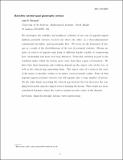Files in this item
Baroclinic toroidal quasi-geostrophic vortices
Item metadata
| dc.contributor.author | Reinaud, Jean Noel | |
| dc.date.accessioned | 2020-04-22T15:30:02Z | |
| dc.date.available | 2020-04-22T15:30:02Z | |
| dc.date.issued | 2020-05-04 | |
| dc.identifier | 267533783 | |
| dc.identifier | a522df16-ea01-4be6-9da8-5e1d482cae64 | |
| dc.identifier | 000533633100001 | |
| dc.identifier | 85092385822 | |
| dc.identifier.citation | Reinaud , J N 2020 , ' Baroclinic toroidal quasi-geostrophic vortices ' , Physics of Fluids , vol. 32 , no. 5 , 056601 . https://doi.org/10.1063/5.0005942 | en |
| dc.identifier.issn | 1070-6631 | |
| dc.identifier.other | ORCID: /0000-0001-5449-6628/work/73701252 | |
| dc.identifier.uri | https://hdl.handle.net/10023/19840 | |
| dc.description.abstract | We investigate the stability and nonlinear evolution of two tori of opposite-signed uniform potential vorticity, located one above the other, in a three-dimensional, continuously-stratified, quasi-geostrophic flow. We focus on the formation of het- ons as a result of the destabilisation of the tori of potential vorticity. Hetons are pairs of vortices of opposite-sign lying at different depths capable of transporting heat, momentum and mass over large distances. Particular attention is paid to the condition under which the hetons move away from their region of formation. We show that their formation and evolution depend on the aspect ratio of the tori, as well as the vertical gap separating them. The aspect ratio of a torus is the ratio of his major (centreline) radius to its minor (cross-sectional) radius. Pairs of thin opposite-signed potential vorticity tori self-organise into a large number of hetons. On the other hand, increasing the vertical gap between the tori decreases the cou- pling between the opposite-signed vortices forming the hetons. This results in a more convoluted dynamics where the vortices remain near the centre of the domain. | |
| dc.format.extent | 15 | |
| dc.format.extent | 1519781 | |
| dc.language.iso | eng | |
| dc.relation.ispartof | Physics of Fluids | en |
| dc.subject | Quasi-geostophy | en |
| dc.subject | Hetons | en |
| dc.subject | Vortex interactions | en |
| dc.subject | QA Mathematics | en |
| dc.subject | QC Physics | en |
| dc.subject | T-NDAS | en |
| dc.subject | BDC | en |
| dc.subject | R2C | en |
| dc.subject.lcc | QA | en |
| dc.subject.lcc | QC | en |
| dc.title | Baroclinic toroidal quasi-geostrophic vortices | en |
| dc.type | Journal article | en |
| dc.contributor.institution | University of St Andrews. Applied Mathematics | en |
| dc.contributor.institution | University of St Andrews. Scottish Oceans Institute | en |
| dc.identifier.doi | 10.1063/5.0005942 | |
| dc.description.status | Peer reviewed | en |
This item appears in the following Collection(s)
Items in the St Andrews Research Repository are protected by copyright, with all rights reserved, unless otherwise indicated.

